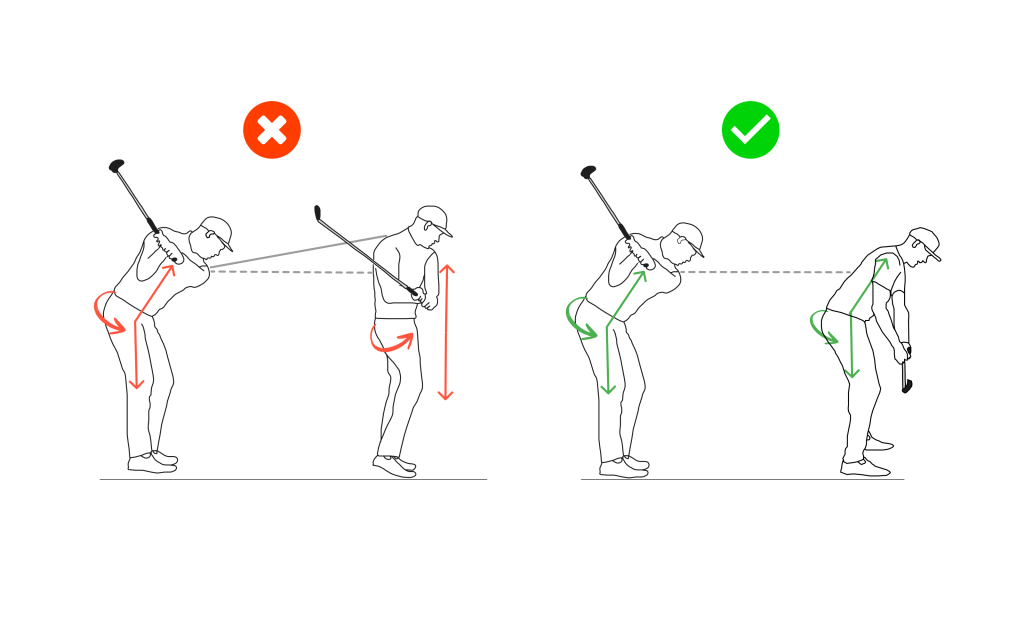
As per TPI, Early Extension is defined as any forward movement (thrust) of the lower body towards the golf ball during the downswing. This swing characteristic causes the arms and club to get stuck behind your body during the downswing, and forces your torso to raise up and elevate through the hitting zone.
Alternate names
Standing up in Downswing
Causes of Early Extension
Early extension in a golf swing is typically caused by a combination of factors including:
Limited hip mobility, poor core strength, incorrect weight transfer, fear of hitting the ground, an over-the-top swing path, improper setup posture, and a lack of flexibility in the lower back, hamstrings, or hips; essentially, the golfer’s body straightens up too early in the downswing, often due to issues with lower body rotation and stability
Incorrect Weight Transfer: Not shifting weight properly from the back foot to the front foot during the downswing can cause the body to straighten up prematurely.
Poor Setup Posture: An incorrect posture at address, like an arched back, can put the golfer in a position where they are more likely to extend early.
Fear of Hitting the Ground: A subconscious fear of “chunking” the ball can cause the golfer to lift up too early in the downswing.
Drills to Fix the Issue
Wall Glute Contact Drill
Prevents early extension by training proper hip rotation and maintaining posture using physical feedback.
- Take your golf stance with both glutes lightly touching a wall, alignment stick, or chair behind you.
- Begin a slow, controlled backswing while keeping contact with the wall.
- As you swing back, feel your trail-side glute stay connected to the wall.
- In the downswing and follow-through, rotate your hips so your lead-side glute takes over contact without pushing off the wall.
- Focus on maintaining pressure against the wall throughout — this prevents the hips from thrusting forward (early extension).
- Repeat to build muscle memory for staying in posture while rotating.
🎯 Goal: Eliminate early extension by reinforcing proper hip rotation and spine angle through impact.
Trail Side Rotation & Low Release Drill
A three-part progression to train proper hip rotation, swing tempo, and forward shaft lean — all while eliminating early extension.
Trail Hip Pinch (Step 1)
- Stand in your normal golf stance without a club.
- Place a golf ball lightly against your trail hip, holding it in place with your trail hand.
- Begin a slow backswing, allowing your body to turn naturally.
- As you transition into the follow-through, pinch the ball into your trail hip using your hip and abdomen in a squat-like motion.
- This builds awareness of trail-side engagement and prevents thrusting forward.
Tempo Swing Progression (Step 2)
- Now move to swinging without a club, starting with chip-length motions using your trail arm.
- Focus on a smooth, even tempo — same speed back and through.
- Gradually build to half swings, then three-quarter, and finally full swings while maintaining rhythm and balance.
- Stay connected and rotate without lifting up.
Low Release Throw (Step 3)
- Continue holding the ball in your trail hand.
- In the follow-through, lower your upper body and simulate throwing the ball forward from a low angle.
- Keep your trail shoulder down and chest over the imaginary ball at impact.
- This promotes forward shaft lean and a strong release position while keeping your body down through the strike.
🎯 Goal: Prevent early extension by engaging the trail side, maintaining rhythm, and promoting a powerful, low-angle release through impact.
Knee-to-Chair Drill
Prevents early extension by promoting proper lower body rotation and posture control.
- Place a chair behind you and stand with your heels lightly touching the base of the chair.
- Take your normal golf stance.
- As you begin your backswing, allow your lead knee to gently touch the chair — this encourages proper hip depth and rotation.
- In the follow-through, let your trail knee touch the chair, maintaining posture and preventing your hips from thrusting forward.
- Avoid losing contact with the chair through early extension — focus on rotation, not rising.
- Repeat until the knee movements feel natural and controlled.
🎯 Goal: Stop early extension by training dynamic lower body movement while maintaining posture throughout the swing.
Physical Limitations Contributing to the Error
Lack of lower body flexibility: mainly tightness in the hips, hamstrings, or lower back.
Incorrect weight transfer: failure to properly shift weight.
Lack of core stability: Poor stability in the core muscles.
Glute Bridges – Strengthens glutes to support hip depth.
90/90 Hip Mobility Drill – Improves hip rotation range.
Bird Dogs or Dead Bugs – Builds core strength and control.
How to Adapt Your Swing to Physical Limitations
- Use a shorter swing to reduce strain on posture.
- Slightly widen your stance for more balance and hip space.
- Flare your lead foot out to promote better hip clearance and rotation.Widen stance or flare feet to improve rotation without head lift
Related Swing Errors
Precursor Errors (Triggering Issues)- Poor posture at setup – Too upright or slouched setup encourages early extension.
- Lack of backswing coil – Without proper loading, the body lunges forward.
- Casting – Hips stall and hands release early.
- Inconsistent contact – Thin, fat, or toe shots from standing up early.
Tools and Training Aids
- Wall Behind Hips – Feedback to maintain hip depth
- Chair or Box – Helps simulate sit-back feel during swing.
- Alignment Stick Across Belt – Visual cue for keeping hips from thrusting forward.
